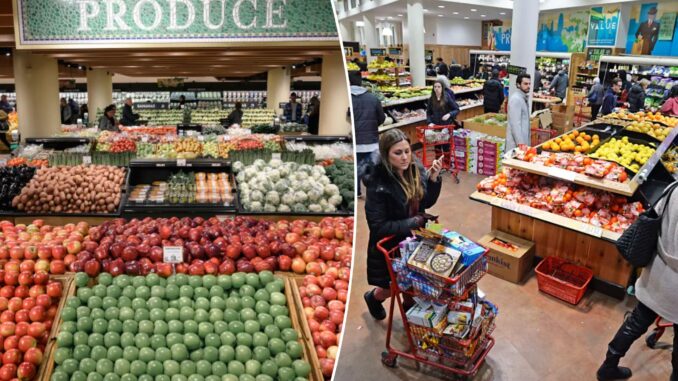
Across the city’s boroughs, grocery stores are seeing green. The craters left by now-defunct big-box retail outlets, casualties of the pandemic, are proving to be fruitful opportunities for well-positioned purveyors of perishables.
“COVID helped to create dynamics that have made this a golden era,” said Peter Ripka of Ripco Real Estate of the grocery boom.
Not only did the pandemic years teach New Yorkers what that four-eyed appliance in their kitchen was for, it taught them to use it with gusto. Today, your average Joe can soufflé and fricassée like Escoffier. They shop local, too, thanks to more flexible office hours.
New residential towers along the Brooklyn and Queens waterfronts have created an explosion in demand for foodstuff. And while a great many have discovered that it’s worth the tip to have their rations delivered, ecommerce has helped, rather than hurt.
“The current view emphasizes a mixed model, where e-commerce remains a vital avenue for growth, but brick-and-mortar stores are key pillars of the supply chain,” reported real estate analyst Green Street in February.
One of the city’s most recent demonstrations of brick-and-mortar might comes from Whole Foods, which opened in the base of Harry Macklowe’s 1 Wall St. in the Financial District in 42,000 square feet, and has plans to open smaller, 7,000- to 14,000-square-foot Whole Foods Daily Shop outposts to squeeze into urban spaces with the first, at 1175 Third Ave., to open later this year.
“COVID helped to create dynamics that have made this a golden era.”
“It’s always hard for growing supermarkets to find space in Manhattan,” said Jeffrey Roseman of Newmark who leased the city’s first Whole Foods in Chelsea in 1999. “Rent is the key — they can’t pay a lot of rent.”
It’s hard to find 50,000 square feet that checks all the boxes and is affordable. “That’s why Whole Foods has gone to a smaller model.”
But others aren’t afraid to go big. A CBRE group is marketing 42,009 square feet of retail on two levels in the base of Taconic’s new 330-unit apartment building on West 42nd Street across from the Port Authority.
“We have a handful of letters of intent from different supermarkets,” said Lon Rubackin of CBRE. “If you asked if we would have a supermarket on the site a few years ago, I would not have believed it. They are all fighting for the same spot, but there is so much residential there now and the grocers all recognize [the demand].”
Everywhere, new developments are a fertile source of space and local mart Brooklyn Fare will open its largest location this spring in a 25,000-square-foot store across two floors at the base of One Manhattan Square at 227 Cherry St., said Alan Oppenheimer of Extell.
For a set of quality-starved New Yorkers, the opening of Wegmans in the Brooklyn Navy Yard was reason to rejoice. But you might have thought the Yankees won the World Series when the upstate New York chain opened a second location at Vornado’s 770 Broadway in Astor Place last October. Fans lined up around the block.
Now, a third location is slated for the 51,000-square-foot cavern left by Bed Bath & Beyond at Glenwood Management’s 1932 Broadway, near Lincoln Center.
Other, bigger chains that are also pushing their way into the city include German-based Aldi. Since 1979, Aldi has owned beloved brand Trader Joe’s, which has a beehive of “crewmates” restocking items and operating dozens of cash registers to move the highest foot traffic per square foot in the industry, according to Green Street and Placer.ai. It’s now expanding with a new store in Harlem opening later this year at 123 W. 125th St.
“It’s always hard for growing supermarkets to find space in Manhattan. Rent is the key — they can’t pay a lot of rent.”
Aldi competitor Lidl, another affordable German-based grocer, is also making area inroads with several new outposts in Staten Island, Harlem and Queens. It’s taking over the former Michaels at both the Bronx Terminal Market and in Fresh Meadows. The chain leased a former 51,000-square-foot Key Foods at the Feil Organization’s Glen Oaks Shopping Center and has two others opening in Brooklyn in a rental project in Crown Heights and another on Fulton St.
In Park Slope, Lidl will replace a Key Foods where William Macklowe and GreenBarn are building a twin-building, low-rise project at 120 Fifth Ave. Macklowe called it “a perfect fit” and “a terrific add to the neighborhood.”
“When we open in Park Slope, it’s going to be a game changer,” said Lidl’s Or Raitses. “We’re bringing down the price of groceries all over New York City. It’s really important to us as part of our mission.”
But Manhattan is hungry for discounts, too. In Chelsea, Lidl will open in MAG Partners’ new apartment building on Penn South’s land at Eighth Avenue and West 26 Street — the former site of a Gristedes. “It is beyond rare for a supermarket to sign a lease before a shovel was ever put in the ground and this is a testament to the need for affordable supermarkets in the city,” said MaryAnne Gilmartin, the developer.
But NYC’s best-known grocery king, Red Apple and Gristedes’s John Catsimatidis, is not expanding. His union shops are more expensive and recent thefts have increased losses from 1.5% to 6%. “Does the city belong to the criminals or to common sense New Yorkers?” he asked.
Real Estate – Latest NYC, US & Celebrity News | New York Post



